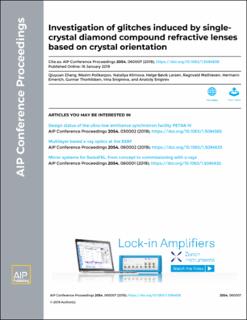| dc.contributor.author | Zhang, Qiuyuan | |
| dc.contributor.author | Polikarpov, Maxim | |
| dc.contributor.author | Nataliya, Klimova | |
| dc.contributor.author | Larsen, Helge Bøvik | |
| dc.contributor.author | Mathiesen, Ragnvald | |
| dc.contributor.author | Emerich, Hermann | |
| dc.contributor.author | Thorkildsen, Gunnar | |
| dc.contributor.author | Snigireva, Irina | |
| dc.contributor.author | Snigirev, Anatoly | |
| dc.date.accessioned | 2023-01-19T12:27:28Z | |
| dc.date.available | 2023-01-19T12:27:28Z | |
| dc.date.created | 2019-01-17T11:42:55Z | |
| dc.date.issued | 2019 | |
| dc.identifier.citation | Zhang, Q., Polikarpov, M., Klimova, N., Larsen, H. B., Mathiesen, R., Emerich, H., ... & Snigirev, A. (2019, January). Investigation of glitches induced by single-crystal diamond compound refractive lenses based on crystal orientation. In AIP Conference Proceedings (Vol. 2054, No. 1, p. 060007). AIP Publishing LLC. | en_US |
| dc.identifier.issn | 0094-243X | |
| dc.identifier.uri | https://hdl.handle.net/11250/3044597 | |
| dc.description.abstract | Single-crystal diamond is considered as an ideal material for compound refractive lenses (usually abbreviated to “CRLs”) mainly due to its stability when bathed in strong X-ray radiation. Since CRLs come into operation by a refractive mechanism, it is imperative to study the transmission spectrum carefully. Many factors may influence the spectrum, including experimental features (such as beam divergence) and crystal orientation in this case. To verify initial assumptions, two experimental setups were realized - the energy scan and ω-scan. Both at BM31 station, ESRF. The results show that a number of glitches appear between 16 keV and 18 keV and the largest drop of intensity can reach up to approximately 40%. In this paper, we find that both positions and strengths of the predicted glitches are very sensitive to orientational correction, but that we in principle are able to predict them accurately when the real orientation is obtained. | en_US |
| dc.language.iso | eng | en_US |
| dc.publisher | AIP Publishing | en_US |
| dc.title | Investigation of glitches induced by single-crystal diamond compound refractive lenses based on crystal orientation | en_US |
| dc.type | Peer reviewed | en_US |
| dc.type | Journal article | en_US |
| dc.description.version | publishedVersion | en_US |
| dc.rights.holder | The authors | en_US |
| dc.subject.nsi | VDP::Matematikk og Naturvitenskap: 400 | en_US |
| dc.source.pagenumber | 1-6 | en_US |
| dc.source.volume | 2054 | en_US |
| dc.source.journal | AIP Conference Proceedings | en_US |
| dc.source.issue | 1 | en_US |
| dc.identifier.doi | 10.1063/1.5084638 | |
| dc.identifier.cristin | 1659178 | |
| cristin.unitcode | 217,8,2,0 | |
| cristin.unitname | Institutt for matematikk og fysikk | |
| cristin.ispublished | true | |
| cristin.fulltext | original | |
| cristin.qualitycode | 1 | |
